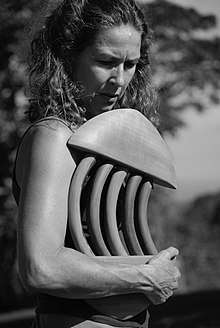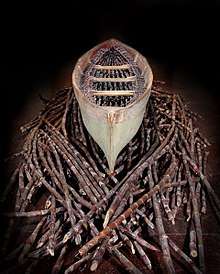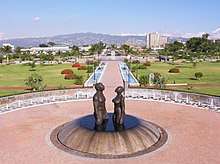Laura Facey
Laura Facey CD (born 31 May 1954) is a Jamaican contemporary artist. She is best known for the monumental sculpture Redemption Song (2003), which serves as Jamaica's national monument to the Emancipation from Slavery.
Laura Facey | |
|---|---|
 Laura Facey, with Harp Arrow | |
| Born | 31 May 1954 |
| Nationality | Jamaican |
| Education |
|
| Known for | Sculpture, installation art |
Biography
Laura Facey was born in Kingston, Jamaica, to the Jamaican businessman Maurice Facey, OJ, who was also the founding Chairman of the National Gallery of Jamaica, and his spouse, book publisher Valerie Facey. She was trained at the West Surrey College of Art & Design, Farnham, England, and the Jamaica School of Art in Kingston, Jamaica (now: the Edna Manley College of the Visual and Performing Arts) where she obtained a diploma in Sculpture in 1975.[1]
Laura Facey lives in the hills of St Ann, Jamaica, where she combines her artwork with organic farming and community development work. In 2014, she received the Order of Distinction, Commander Class (CD), one of Jamaica's national honours.[2]
Work
As a sculptor, Laura Facey has worked in bronze, stone and unconventional materials such as Styrofoam, but she is best known for her work in woodcarving. She was one of the first artists in Jamaica to produce assemblage and installation art, often incorporating found objects with carved elements. She was featured in the National Gallery of Jamaica's Six Options: Gallery Spaces Transformed (1985), which was the first exhibition of installation art in Jamaica.[3] Facey also works in drawing and fine art print media, and she has illustrated two children's books, both on environmental themes: Talisman the Goat (1976) and Chairworm and Supershark (1992). The latter was written by the maritime conservationist Elisabeth Mann Borgese.
The human body and the land, sea and natural bounty of Jamaica have provided Laura Facey with a range of metaphors to address themes of personal and collective trauma and of spiritual transformation, transcendence and healing. This is illustrated by her autobiographical mixed media installation The Goddess of Change (1993), in the collection of the National Gallery of Jamaica, and the life-size wood-carving of Christ Ascending (2001) which was commissioned for the St. Andrew Parish Church in Kingston, Jamaica. The latter is one of several religious artworks by Facey.[4]

Facey's work on the 2003 Emancipation monument marked the start of a sustained thematic interest in the legacy of plantation slavery, as an experience of collective trauma and a defining moment in Jamaican history. Her installation, Their Spirits Gone Before Them (2006), consists of a traditional Jamaican cottonwood dugout canoe resting on a "sea" of sugar cane and in which she mounted 1,357 resin figures (miniatures of the male and female figures of the Redemption Song monument). The work alludes to the Middle Passage as a key moment of trauma and transformation that birthed modern Caribbean society and culture. Their Spirits Gone Before Them was endorsed by UNESCO’s Slave Route Project and has been featured in several exhibitions, such as Facey's 2014 solo exhibition at the International Slavery Museum in Liverpool.[5][6]
Scale is an important part of Facey's work, which ranges from miniature to monumental, and her artworks have a tactile, performative and interactive quality. Ceiba (2016), a giant drum made from a hollowed-out silk cotton tree trunk, was exhibited at the Jamaica Biennial 2017, where it was used for a performance at the opening function, and visitors were allowed to interact with it by beating the drum.[7] The dramatic potential of shifting scale is also used in Facey's giant tool forms which exploit the symbolic potential of tools, as devices that build, mend, untangle and transport.[8] Walking Tree, one of giant comb forms produced by Facey, which was first shown at the Jamaica Biennial 2014, was acquired by the Norman Manley International Airport in Kingston, Jamaica, where it is on permanent view in the ticketing hall.[9][10]
 Laura Facey - Goddess of Change (1993), Collection: National Gallery of Jamaica
Laura Facey - Goddess of Change (1993), Collection: National Gallery of Jamaica Laura Facey - Christ Ascending (2001), St Andrew Parish Church, Kingston, Jamaica
Laura Facey - Christ Ascending (2001), St Andrew Parish Church, Kingston, Jamaica Laura Facey - Walking Tree (2012), Norman Manley International Airport, Kingston, Jamaica
Laura Facey - Walking Tree (2012), Norman Manley International Airport, Kingston, Jamaica Laura Facey - Ceiba (2016), in Facey's studio in St Ann, Jamaica
Laura Facey - Ceiba (2016), in Facey's studio in St Ann, Jamaica
Redemption Song

In 1997, Jamaica re-instituted 1 August as the annual Emancipation Day holiday, after it had been subsumed under the annual 6 August Independence Day Holiday since Independence in 1962.[11] This was part of a broader campaign to re-position the end of slavery as a defining moment in Jamaican history. Related initiatives included the establishment of the new Emancipation Park in Kingston, which was developed by the Jamaican National Housing Trust and which opened in 2002.
A sculpture competition for the park was launched and the winning entry was Laura Facey's Redemption Song, which is named after Bob Marley’s Redemption Song and inspired by the line "none but ourselves can free our minds." Redemption Song, which was unveiled on the eve of Emancipation Day, on 31 July 2003, consists of two nude bronze figures, male and female, who stand in a round pool of water, which is part of the monument's fountain base, and who gaze up to the sky. Laura Facey outlined her intent in the programme brochure for the unveiling: "My piece is not about ropes, chains or torture; I have gone beyond that. I wanted to create a sculpture that communicates transcendence, reverence, strength and unity through our pro-creators—man and woman—all of which comes when the mind is free."[12]
While intended as a hopeful and unifying image of spiritual transcendence and healing, Redemption Song did not find favour with all and the resulting controversy lasted for several months and reached the international media.[13] The debate revolved mainly around the nudity, passivity and lack of historical specificity of the statues, as well as around the identity of the artist as a light-skinned Jamaican, and whether these choices were appropriate for a public monument to Emancipation.[14][15][16] These criticisms still linger today but the monument is now an established Kingston landmark.
Exhibitions
- Solo Exhibitions
- 2018 - Laura Facey, Harmony Hall, Tower Isle, St Mary, Jamaica
- 2014 - Their Spirits, International Slavery Museum, Liverpool, UK[6]
- 2013 - Radiant Earth, The Prince's School of Traditional Arts, London, UK[17]
- 2011 - Radiant Combs, Mt Plenty, St Ann, Jamaica
- 2010 - Propel, ROKTOWA, Kingston, Jamaica
- 2006 - The Everything Doors, Institute of Jamaica, Kingston, Jamaica[18]
- 2001 - Silent Voices, Bolivar Gallery, Kingston, Jamaica
- 1985 - Pieces, Mutual Life Gallery, Kingston, Jamaica
- 1980 - Works, Tom Martin Gallery, Santa Fe, New Mexico, USA
- Group Exhibitions
- 2017, 2014 - Jamaica Biennial, National Gallery of Jamaica[7][9]
- 2012, 2010 - National Biennial, National Gallery of Jamaica[19]
- 2011 - About Change, World Bank, Washington DC, USA[20]
- 2007 - Materialising Slavery, National Gallery of Jamaica
- 1997 - Sexta Bienal de la Habana, Havana, Cuba[21]
- 1990 - Laura Facey & Cecil Ward, Patoo Gallery, Kingston, Jamaica
- 1986 - Caribbean Art Now, Commonwealth Institute, London, UK
- 1985 - Six Options: Gallery Spaces Transformed, National Gallery of Jamaica[3]
Commissions
Awards
- 2014 - Order of Distinction, Commander Rank (CD), Jamaican National Honours[2]
- 2010 - Aaron Matalon Award, National Biennial, National Gallery of Jamaica[19]
- 2006 - Silver Musgrave Medal, Institute of Jamaica[23]
References
- Boxer, David; Poupeye, Veerle (1998). Modern Jamaican Art. Ian Randle Publishers. pp. 31–32 & 182.
- "National Honours and Awards" (PDF). Jamaica Information Service. 2014. Retrieved 21 April 2018.
- Poupeye, Veerle (1985). "Six Options: Gallery Spaces Transformed". Arts Jamaica. 4: 1&2: 2–8.
- Archer-Straw, Petrine (2003). "Laura Facey: Beauty and the Beast". Caribbean Beat. 60.
- "The Slave Route". UNESCO. Retrieved 21 April 2018.
- "Their Spirits". International Slavery Museum. 2014. Retrieved 21 April 2018.
- "Jamaica Biennial 2017 - Invited Artists: Laura Facey". National Gallery of Jamaica. 2017. Retrieved 21 April 2018.
- Bynoe, Holly (7 November 2011). "Art Transforming the World in Conversation with Laura Facey". ARC Magazine.
- "Jamaica Biennial 2014 - Behind the Scenes: The Installation of Laura Facey's Walking Tree ad Needle for the Planet". National Gallery of Jamaica. 2015. Retrieved 21 April 2018.
- "Art in Transit: Works of Art Take Off at NMIA". Jamaica Gleaner. 19 July 2015. Retrieved 21 April 2018.
- Jamaica Information Service (1996). "Report on National Symbols and Observances".
- National Housing Trust (31 July 2003). Programme Brochure of Unveiling of Redemption Song.
- Younge, Gary (14 August 2003). "Size Does Matter, Jamaicans Decide". Guardian. Retrieved 21 April 2018.
- Dacres, Petrina (2004). "Monument and Meaning". Small Axe. 16: 137–154.
- Dacres, Petrina (2004). "An Interview with Laura Facey Cooper". Small Axe. 16: 125–136.
- Poupeye, Veerle (2004). "A Monument in the Public Sphere: The Controversy about Laura Facey's Redemption Song". Jamaica Journal. 28: 3&4: 36–47.
- "A Touch of Jamaican Healing with 'Radiant Earth' Artist Laura Facey". Parlour. 25 September 2013.
- Poupeye, Veerle (2008). "Liminal Spaces: Laura Facey's The Everything Doors". Jamaica Journal. 31: 1&2: 72–79.
- "National Biennial: Laura Facey Wins Aaron Matalon Award". National Gallery of Jamaica. 2012. Retrieved 21 April 2018.
- "About Change". World Bank. 2011. Retrieved 21 April 2018.
- "6th Havana Biennal". Universes in Universe. 1997. Retrieved 21 April 2018.
- "Earth to Earth". University of Technology, Centre for the Arts. Retrieved 21 April 2018.
- "Institute of Jamaica Awards 9 Musgrave Medals". Jamaica Information Service. 5 October 2006. Retrieved 21 April 2018.